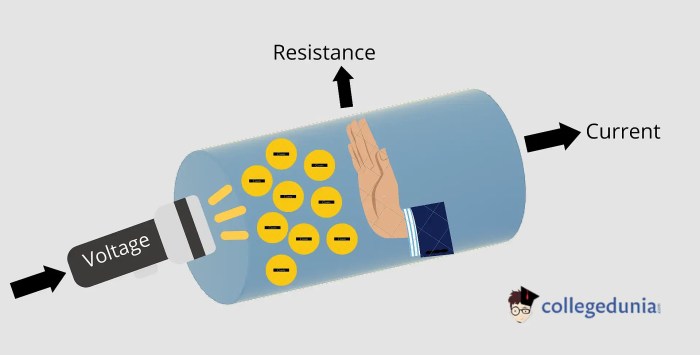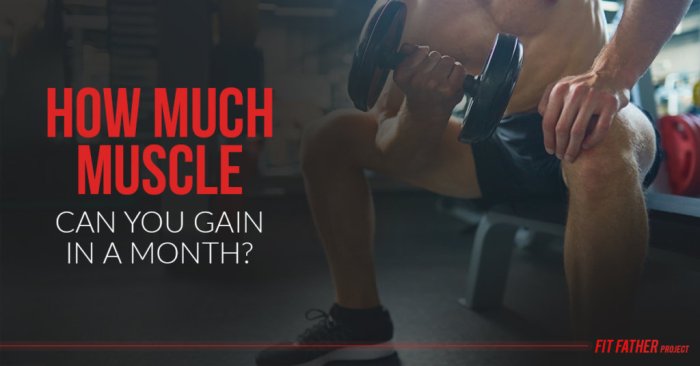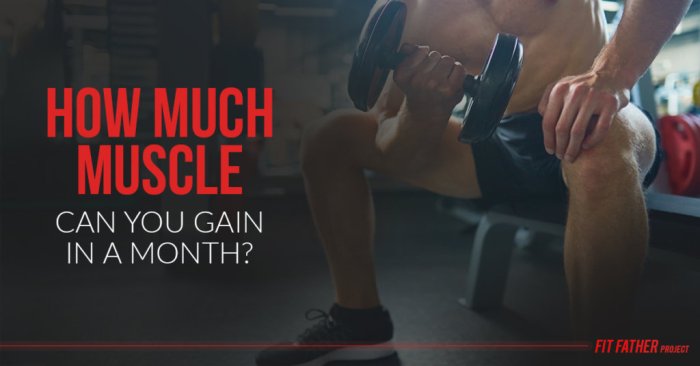How to use resistance bands? This guide dives deep into the world of resistance band workouts, revealing the secrets to unlocking your fitness potential. We’ll explore different band types, from color-coded to loop bands, and their varying strengths. You’ll discover a range of exercises, from beginner basics to advanced techniques, and learn how to tailor workouts to your specific goals.
From selecting the perfect band for your needs to mastering proper form, this comprehensive guide provides practical steps to ensure you use resistance bands safely and effectively. We’ll also cover crucial aspects like workout routines, modifications for injuries, and the essential equipment to optimize your experience.
Introduction to Resistance Bands
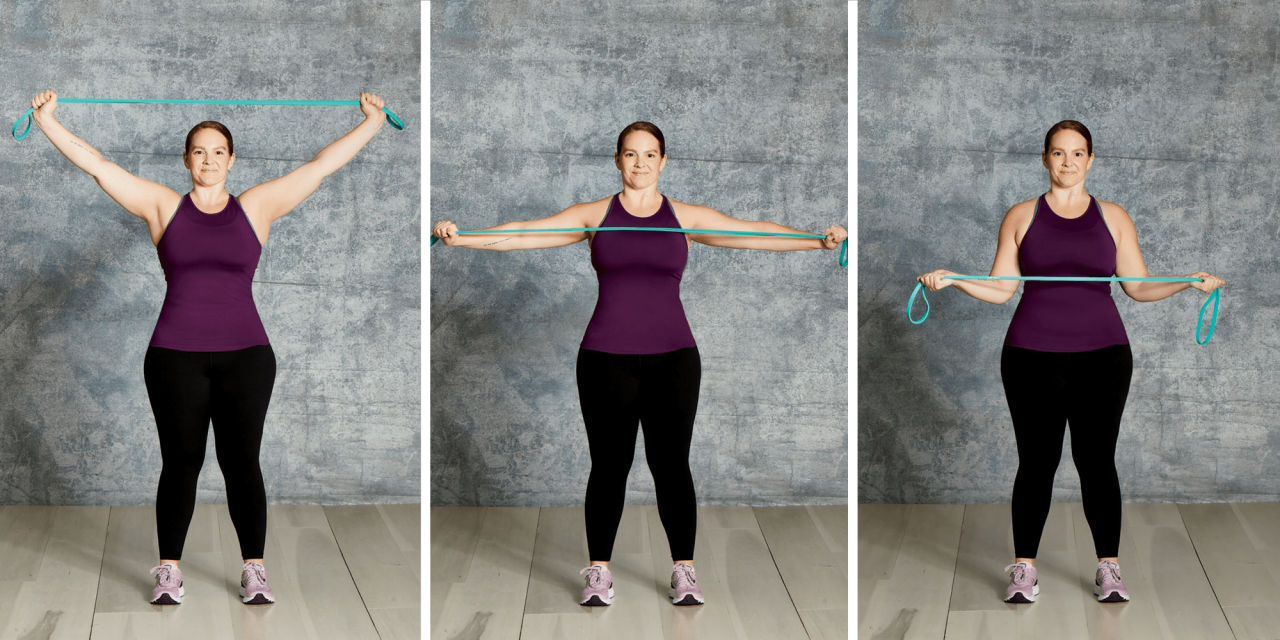
Resistance bands are elastic bands that provide variable resistance for exercises. They are a versatile and affordable tool for improving strength, flexibility, and overall fitness. Resistance bands are used in various workouts, from building muscle to rehabilitating injuries, making them a valuable addition to any fitness routine.Resistance bands come in different types and levels of resistance, allowing users to tailor their workouts to their specific needs and goals.
The varying levels of tension provided by different bands help to gradually increase the intensity of your workouts as your strength improves.
Types of Resistance Bands
Resistance bands are categorized by their color-coding, material, and loop style, each offering varying degrees of resistance. Understanding these differences helps users select the right band for their fitness level and goals.
- Color-Coded Bands: These bands are typically color-coded, with darker colors indicating higher resistance. A lighter color band provides less resistance and is ideal for beginners or those seeking a gentler workout. This color-coding system provides a simple way to choose the appropriate level of resistance for various exercises.
- Loop Bands: These bands feature a loop at each end, allowing for various gripping and attachment methods. They are highly versatile and suitable for a wide range of exercises. The loop design facilitates a wider range of movement compared to other band types.
- Tube Bands: These bands have a tube-like structure, offering a consistent level of resistance throughout the exercise. The uniform resistance provided by tube bands is suitable for exercises that require a steady tension. They are particularly useful for exercises that target specific muscle groups with consistent resistance.
- Mini Bands: Mini bands are small, lightweight bands ideal for exercises that focus on smaller muscle groups. Their portability makes them a convenient option for travel and home workouts. Mini bands are perfect for targeting specific muscle groups, especially in areas like the glutes and hips.
Resistance Band Exercise Examples
Resistance bands can be incorporated into a multitude of exercises to enhance strength training, rehabilitation, or general fitness. The variety of exercises possible with resistance bands is a key advantage in fitness routines.
- Bicep Curls: Loop bands can be used for bicep curls, providing resistance as you curl the band towards your shoulders. This exercise is effective in strengthening the biceps and forearms.
- Leg Raises: Loop bands can be used for leg raises, offering resistance as you lift your legs while lying down. This exercise is helpful in strengthening the core and hip flexors.
- Tricep Extensions: Tube bands can be used for tricep extensions, providing resistance as you extend your arms behind you. This exercise targets the triceps muscles and promotes arm strength.
- Glute Bridges: Mini bands can be used for glute bridges, providing resistance as you lift your hips off the ground. This exercise is effective in strengthening the glutes and core.
Common Misconceptions
Some common misconceptions about resistance bands include their limited effectiveness and suitability only for beginners.
- Resistance bands are only for beginners: While they are accessible to beginners, resistance bands are effective for individuals of all fitness levels. Experienced athletes can use them to increase the intensity of their workouts or target specific muscle groups. The varied resistance levels allow for personalized workouts for any fitness level.
- Resistance bands offer limited strength gains: Resistance bands are a powerful tool for building strength and muscle, comparable to free weights for specific exercises. The progressive resistance of the bands allows for gradual strength improvement. Consistent use with the right exercises can produce significant gains in strength and muscle mass.
- Resistance bands are not effective for compound exercises: Resistance bands can be incorporated into compound exercises. They can be used to modify compound exercises, adding resistance or targeting specific muscle groups more effectively. Compound exercises like squats, lunges, and rows can be enhanced with the use of resistance bands.
Benefits of Resistance Bands
Resistance bands offer numerous benefits, including affordability, portability, and effectiveness for various fitness goals.
- Affordability and Portability: Resistance bands are significantly more affordable and portable than many other fitness equipment options. They are a cost-effective solution for those looking to enhance their workouts without a large investment.
- Versatility and Adaptability: Resistance bands are highly versatile and can be adapted to a wide range of exercises, targeting different muscle groups. They can be used for a variety of exercises, from basic to advanced, providing flexibility in workouts.
- Injury Prevention and Rehabilitation: Resistance bands can be used for injury prevention and rehabilitation. They provide a way to strengthen muscles and improve mobility, helping to prevent injuries. They are particularly helpful in rehabilitating injuries, as they provide controlled resistance.
Getting Started with Resistance Bands
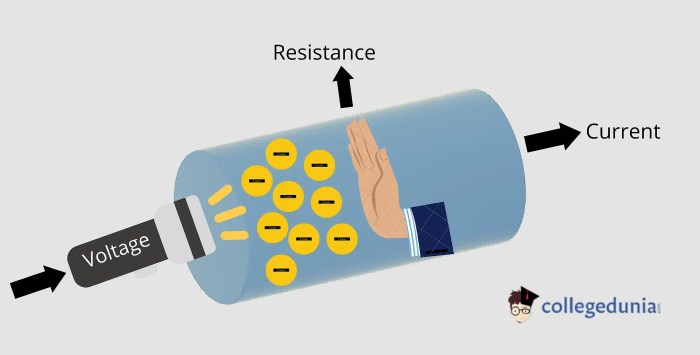
Resistance bands offer a fantastic, portable, and affordable way to build strength and improve fitness. However, like any exercise equipment, proper form and technique are crucial for safety and effectiveness. Understanding how to select the right band for your needs, and how to anchor them securely, are key components to maximizing your workout. This guide will walk you through the essentials to get started with resistance bands.
Importance of Proper Form and Technique
Proper form and technique when using resistance bands prevent injuries and ensure you’re targeting the correct muscles. Incorrect form can lead to strain, tears, and other issues. Maintain a controlled and consistent movement throughout each exercise, focusing on the muscle groups being worked. Avoid jerking or bouncing, as this can lead to injury. Breathing correctly throughout the exercise is also essential for optimal performance and preventing fatigue.
Selecting the Right Resistance Band
Choosing the right resistance band is essential for achieving your fitness goals. A band that’s too light won’t provide enough resistance, while one that’s too heavy can lead to injury and frustration. Consider the exercises you plan to perform and the level of your current fitness. Start with a band that challenges you, but doesn’t leave you feeling overly fatigued.
Gradually increase the resistance as your strength improves. A general rule is to choose a band that allows you to complete 10-15 repetitions with good form.
Anchoring Resistance Bands
Various anchoring methods are available, each with its own advantages and disadvantages. Proper anchoring is vital for maintaining stability and safety. Choosing the right method depends on the exercise and the space available.
Safety Precautions
Always prioritize safety when using resistance bands. Inspect the band for any tears or damage before each use. Never overstretch the band, as this can weaken it and increase the risk of injury. If you feel any sharp pain, stop the exercise immediately. Keep children and pets away from the bands when in use.
Work out in a well-lit and spacious area to avoid accidents. Ensure the anchoring point is secure and stable to prevent the band from snapping or shifting.
Resistance bands are a fantastic way to add some extra challenge to your workouts. To get the most out of them, make sure you anchor them securely, and gradually increase the resistance as you get stronger. While you’re focusing on your fitness, it’s also important to consider the safety aspects of the things you consume, like yerba mate tea.
Learning about its potential benefits and possible risks is key, and a great resource for that is this article on yerba mate tea uses safety. Remember to listen to your body and adjust the exercises as needed. Ultimately, using resistance bands effectively is about proper form and consistent practice.
Comparison of Anchoring Methods
| Method | Description | Pros | Cons |
|---|---|---|---|
| Door Anchor | Attach the band to a sturdy door frame. | Convenient, portable, and effective for many exercises. | Limited space; can be difficult to adjust resistance for certain exercises. |
| Anchor to a Stable Object | Securely attach the band to a stable object like a sturdy chair or pole. | Offers more flexibility in positioning, allowing for diverse exercises. | Requires a stable and suitable object. |
| Body Anchor | Use your body (e.g., leg, arm) to anchor the band. | Versatile, requiring no additional equipment; excellent for mobility exercises. | Can be difficult to maintain proper form for certain exercises. |
| Wall Anchor | Use a wall anchor for a stable, fixed point. | Offers a stable and fixed point; great for isolation exercises. | May not be suitable for all spaces. |
Basic Resistance Band Exercises
Resistance bands offer a versatile and convenient way to build strength and improve fitness. They’re portable, inexpensive, and can be used for a wide variety of exercises, targeting different muscle groups. Mastering the fundamentals is key to progressing safely and effectively.Now, let’s delve into some essential exercises you can perform with resistance bands, focusing on proper form, muscle engagement, and progressive overload.
Fundamental Resistance Band Exercises
Understanding the correct execution of basic exercises is crucial for achieving desired results and avoiding injury. These fundamental exercises form a solid foundation for building strength and improving overall fitness.
- Band Bicep Curls: This exercise primarily targets the biceps brachii muscle, a crucial muscle for elbow flexion. Proper form involves holding the band with an overhand grip, keeping your elbows close to your sides, and curling the band towards your shoulders. Maintain a controlled motion throughout the exercise, emphasizing the contraction of the biceps. Start with a light resistance band and gradually increase the tension as you get stronger.
Variations include alternating arm curls and seated curls.
- Band Rows: Band rows are excellent for targeting the back muscles, including the latissimus dorsi and rhomboids. Stand with feet shoulder-width apart, holding the band with an underhand grip. Keeping your back straight and core engaged, pull the band towards your chest, squeezing your shoulder blades together. Lower the band in a controlled manner. A progression involves moving from a standing position to a kneeling position, adjusting the grip width, and increasing band resistance.
- Band Squats: Band squats engage the quadriceps, glutes, and hamstrings, major muscles of the lower body. Hold the band around your thighs, feet shoulder-width apart, and descend into a squat position, ensuring your knees remain behind your toes. Push through your heels to return to the starting position, focusing on maintaining a controlled motion. Consider using a higher resistance band for added intensity, or performing the exercise with a staggered stance for a different challenge.
- Band Chest Press: This exercise strengthens the pectoral muscles. Stand with feet shoulder-width apart, holding the band with both hands, and position the band at chest height. Extend your arms to push the band away, maintaining a controlled motion and focusing on the contraction of your chest muscles. Variations include moving from a standing position to a seated position, or adjusting the angle of the band for a different stimulus.
Using resistance bands is a fantastic way to build strength and tone muscles at home. Just remember to anchor the band securely, and gradually increase the resistance as you get stronger. Incorporating a healthy juice like celery juice into your routine could offer surprising benefits, especially for muscle recovery and overall health. benefits of celery juice can be a powerful complement to your resistance band workouts.
Experiment with different band tensions and exercises to find what works best for you.
- Band Side Lunges: Band side lunges work the glutes, quads, and hip abductors. Stand with feet shoulder-width apart, holding the band around your thighs. Step to the side with one leg, bending both knees to 90 degrees, and maintaining a stable posture. Push off the ground to return to the starting position, repeating with the opposite leg. Gradually increasing the band resistance will increase the challenge.
For added complexity, you can perform the exercise while holding a light dumbbell in each hand.
- Band Calf Raises: Calf raises target the calf muscles (gastrocnemius and soleus). Stand on the band with your feet shoulder-width apart, holding the band around your ankles. Lift your heels off the ground, squeezing your calf muscles at the top of the movement, and lower them in a controlled manner. This exercise is a great addition to any leg workout routine.
Using resistance bands for workouts is super simple. Just loop the band around a sturdy object, like a pole or a chair, and then grab the handles. You can use different band tensions to target specific muscle groups. While we’re on the subject of bodily functions, did you know that boogers are basically just dried nasal mucus and dead skin cells?
You can find out more about what are boogers made of if you’re curious. Once you’ve mastered the basics, you can add variations like squats, rows, and biceps curls to your routine to further strengthen your muscles.
You can increase the intensity by adding weight to your ankles or using a higher resistance band.
Resistance Band Exercise Progression
Progressive overload is essential for continuous muscle growth and strength development. Gradually increasing the resistance, reps, or sets will challenge your muscles and promote adaptation.
| Exercise | Muscles | Sets | Variations |
|---|---|---|---|
| Band Bicep Curls | Biceps Brachii | 3 sets of 10-12 reps | Alternating arm curls, seated curls |
| Band Rows | Latissimus Dorsi, Rhomboids | 3 sets of 8-12 reps | Kneeling rows, different grip widths |
| Band Squats | Quadriceps, Glutes, Hamstrings | 3 sets of 10-15 reps | Staggered stance, higher resistance band |
| Band Chest Press | Pectoralis Major | 3 sets of 10-12 reps | Seated chest press, different band angles |
| Band Side Lunges | Glutes, Quads, Hip Abductors | 3 sets of 10-12 reps per leg | Holding dumbbells, increasing resistance |
| Band Calf Raises | Gastrocnemius, Soleus | 3 sets of 15-20 reps | Adding ankle weight, higher resistance band |
Advanced Resistance Band Exercises
Resistance bands, once considered a beginner’s tool, unlock a world of advanced exercises that challenge your muscles in new and exciting ways. These exercises often demand more coordination, stability, and controlled movements, leading to greater strength gains and improved athletic performance. Proper form is paramount for preventing injury and maximizing results. This section delves into these more complex movements, highlighting their benefits, variations, and progressions.Advanced resistance band exercises build upon the foundation laid by basic exercises, pushing you to the next level of strength and fitness.
They require a deeper understanding of proper technique and a greater degree of muscular engagement. This approach targets specific muscle groups more intensely and often incorporates compound movements that work multiple muscle groups simultaneously.
Advanced Band Exercises for Back Strength
Understanding proper form and technique is critical for effective back exercises with resistance bands. These advanced exercises can help you target specific back muscles, enhancing posture, and reducing the risk of injury.
- Band-Assisted Pull-Aparts: This exercise targets the muscles in your upper back and shoulders, promoting posture improvement. The resistance band creates a pulling force that works your rhomboids and trapezius muscles. The band should be placed behind you, slightly above your upper back, with both hands holding the ends. Start with your arms slightly bent, then pull apart until your arms are straight.
Return slowly to the starting position. This exercise is more challenging than the basic band row, requiring greater control and coordination. Progression can be achieved by increasing the band resistance or by performing the exercise with a wider grip. An alternative to using the band directly behind you is to use a door anchor. This variation further increases the engagement of the back muscles.
- Band Face Pulls: This exercise focuses on the muscles around your shoulders and upper back. It helps to counteract the forward rounding that often occurs with prolonged sitting or desk work. Holding the band with both hands, pull the band towards your face, keeping your elbows slightly bent. Keep tension on the band throughout the movement. A key element is maintaining a controlled movement.
Variations include using a different hand position, such as a wider grip, to target different areas of the back. Increased resistance bands will create a higher level of difficulty.
Advanced Band Exercises for Leg Strength
Resistance bands can effectively strengthen your legs with advanced exercises that target different muscle groups.
- Band Romanian Deadlifts (RDLs): This exercise, a more advanced version of the basic band deadlift, emphasizes the hamstrings and glutes. It’s crucial to maintain a neutral spine throughout the movement. Stand with the band around your mid-foot, hold the band ends, and bend at the hips while keeping your back straight. Focus on pulling the band towards your heels and squeezing your glutes at the top of the movement.
Progressing to a heavier band will increase the challenge. A variation involves performing the exercise on an incline.
- Band Lateral Walks: This exercise challenges your lateral hip abductors and adductors. Holding the resistance band with one hand on each end, step sideways, maintaining tension on the band. This targets the muscles responsible for lateral movement and balance. Progression can be achieved by increasing the band resistance and the length of your steps. You can increase the intensity of this exercise by increasing the tempo of your steps.
Advanced Band Exercise Comparison Table
| Exercise | Basic Equivalent | Target Muscles | Difficulty |
|---|---|---|---|
| Band-Assisted Pull-Aparts | Band Rows | Rhomboids, Trapezius, Rear Deltoids | Medium-High |
| Band Face Pulls | Band Rows | Trapezius, Rear Deltoids, Rotator Cuff | Medium-High |
| Band Romanian Deadlifts | Band Deadlifts | Hamstrings, Glutes, Lower Back | High |
| Band Lateral Walks | Band Side Steps | Hip Abductors, Adductors, Glutes | Medium-High |
Resistance Band Workouts
Resistance bands offer a versatile and effective way to enhance your fitness journey, whether your goal is building strength, improving flexibility, or simply adding variety to your routine. They’re portable, inexpensive, and require minimal space, making them a fantastic addition to any workout regimen. This section will explore different resistance band workouts tailored for various fitness levels and goals, emphasizing the importance of proper rest and recovery.
Sample Resistance Band Workouts
Resistance band workouts can be customized to address specific fitness goals. These workouts should be performed with proper form and intensity to maximize benefits and minimize injury risk. Remember to listen to your body and adjust the resistance level as needed.
Strength Training Workouts, How to use resistance bands
Strength training with resistance bands helps build muscle and improve overall strength. A sample workout for beginners might include band rows, band curls, and band presses, focusing on controlled movements and proper form. Intermediate and advanced users can incorporate more challenging exercises like band squats, band lunges, and band deadlifts, gradually increasing the resistance and reps. Each exercise should be performed with a controlled tempo and sufficient rest between sets to allow for muscle recovery.
Flexibility Workouts
Resistance bands are also excellent tools for improving flexibility and range of motion. Stretching exercises using resistance bands can target specific muscle groups and increase flexibility. Examples include band-assisted hamstring stretches, band-assisted chest stretches, and band-assisted triceps stretches. These exercises should be performed slowly and with a gentle stretch, focusing on maintaining proper posture and avoiding bouncing or jerking motions.
Hold each stretch for 15-30 seconds, repeating the exercise several times for each muscle group.
Beginner Workout Schedule
A beginner workout schedule using resistance bands should prioritize proper form and gradual progression. Begin with 2-3 sessions per week, alternating muscle groups on different days. Each workout should include a warm-up period, followed by 2-3 sets of 10-15 repetitions for each exercise, with adequate rest between sets. Gradually increase the resistance, sets, or repetitions as your strength improves.
Advanced Workout Schedule
An advanced workout schedule can incorporate higher resistance levels, more sets, and higher repetitions. Focus on compound exercises that work multiple muscle groups simultaneously. 3-4 workouts per week, targeting different muscle groups on different days, is recommended. Advanced users can increase the intensity by adding more sets, increasing the resistance level, or performing exercises with a faster tempo.
Benefits of Resistance Bands in a Complete Workout Routine
Resistance bands can be seamlessly integrated into a comprehensive workout routine, enhancing the effectiveness of existing exercises and adding variety. They provide an excellent way to build strength, increase flexibility, and promote overall fitness. Their portability and affordability make them accessible to individuals of all fitness levels and budgets. Their versatility allows for customization to accommodate individual goals and needs.
Importance of Rest and Recovery
Adequate rest and recovery are crucial for muscle growth and injury prevention when using resistance bands. Allowing your muscles to repair and rebuild between workouts is essential for achieving optimal results. Rest days are equally important as workout days, allowing for sufficient recovery time for muscle repair and growth. Listening to your body and adjusting your workout intensity and schedule as needed is critical.
Workout Routines
| Routine Type | Duration | Exercises |
|---|---|---|
| Beginner Strength | 30-45 minutes | Band Rows, Band Curls, Band Press, Band Bicep Curls, Band Tricep Extensions |
| Intermediate Flexibility | 20-30 minutes | Band Assisted Hamstring Stretches, Band Assisted Chest Stretches, Band Assisted Triceps Stretches, Band Assisted Back Stretches |
| Advanced Strength | 45-60 minutes | Band Squats, Band Lunges, Band Deadlifts, Band Overhead Press, Band Pull-Aparts |
Resistance Band Modifications and Considerations
Resistance bands offer a versatile and accessible way to build strength and improve fitness, but proper modification is crucial for maximizing benefits and minimizing risk. Understanding how to adapt exercises for various physical limitations and injuries is essential for safe and effective workouts. This section will detail modifications for specific exercises, emphasizing the importance of listening to your body and adjusting routines accordingly.
Modifications for Physical Limitations and Injuries
Proper form and modifications are paramount when using resistance bands. Adapting exercises for injuries or physical limitations ensures that you work your muscles effectively without aggravating existing conditions. Modifications may involve changing the angle of the band, the type of grip, or the range of motion. This approach allows individuals with varying levels of mobility, strength, and injuries to participate in resistance band workouts safely and effectively.
Modifications for Specific Exercises
Different exercises require different modifications depending on individual needs. This section presents modifications for common resistance band exercises, offering options for accommodating injuries or physical limitations. Understanding these adjustments can greatly improve the effectiveness and safety of your resistance band workouts.
| Exercise | Modification | Target Muscles | Benefits |
|---|---|---|---|
| Band Bicep Curls | Use a lighter band or perform seated curls. | Biceps, Forearms | Reduces stress on the elbows and shoulders, accommodates various strength levels. |
| Band Rows | Modify grip or use a chair for support, reducing the range of motion. | Back muscles (lats, rhomboids, traps), biceps | Reduces stress on lower back and shoulders, accommodates lower back issues or limited mobility. |
| Band Squats | Perform squats against a wall for balance assistance or use a chair for partial squats. | Quads, Glutes, Hamstrings | Reduces stress on knees, accommodates knee pain or limited mobility. Increases stability. |
| Band Chest Press | Perform the exercise seated or modify the grip for more stability. | Chest, Shoulders, Triceps | Reduces stress on the shoulder joints, accommodates shoulder injuries. Offers alternative muscle engagement patterns. |
| Band Leg Raises | Perform the exercise with a neutral band position or use a chair for support. | Abdominals, Hip Flexors | Reduces stress on the lower back, accommodates lower back pain or limited mobility. |
Listening to Your Body
“Listen to your body and adjust exercises as needed.”
It’s crucial to pay attention to any pain or discomfort during your resistance band workout. Adjusting the resistance, range of motion, or exercise itself can prevent injuries and ensure a safe and effective workout. If you experience sharp pain, stop the exercise immediately and consult with a healthcare professional. Consistent and attentive listening to your body is vital for long-term success and well-being.
Resistance Band Equipment and Accessories: How To Use Resistance Bands
Resistance bands are incredibly versatile, but to maximize their effectiveness and safety, understanding and utilizing appropriate equipment and accessories is crucial. Proper accessories can enhance your workout experience, prevent injuries, and allow for more diverse and challenging exercises. This section will delve into various accessories and their roles in your resistance band journey.
Different Types of Resistance Band Equipment and Accessories
Resistance band workouts benefit from a range of accessories that elevate the exercises and improve the overall experience. These range from simple straps and handles to more complex systems. Common additions include: resistance band handles, door anchors, resistance band straps, ankle straps, and resistance band chains. Each accessory offers unique advantages and potential drawbacks.
Resistance Band Handles
Handles provide a more comfortable and often more ergonomic grip, allowing for greater control during exercises like rows, bicep curls, and tricep extensions. Handles also often allow for a wider range of motion and greater force application compared to holding the band directly. Different handle types exist, from simple loop handles to more complex and textured options, each with specific advantages.
Door Anchors
Door anchors provide a secure and adjustable way to anchor the resistance band to a door frame. This allows for a wider variety of exercises, particularly those involving pulling or pushing motions, and can be useful for exercises that need a stable and adjustable anchor point. However, proper door selection and anchoring techniques are vital to prevent damage to the door or the band.
Resistance Band Straps
Resistance band straps are used to attach the band to a fixed point or another part of the body for more effective exercises. They provide a greater range of motion and allow for exercises that might be difficult or impossible with bare hands. Straps also reduce the risk of slippage or discomfort compared to holding the band directly.
Ankle Straps
Ankle straps are a useful accessory for leg exercises like squats and lunges. They secure the resistance band around the ankles, allowing for more focused and controlled movements. This can improve stability and engagement of specific muscle groups in the legs and glutes. Proper strap fitting is important for comfort and preventing discomfort or injury.
Resistance Band Chains
Resistance band chains add a unique dynamic to resistance band workouts. They increase the range of motion and create a varied level of resistance as you move through the exercise. They also provide a higher level of engagement for specific muscle groups. The increased resistance can, however, require more focus and strength to control.
Maintaining and Caring for Resistance Bands
Proper maintenance is essential to prolong the lifespan of your resistance bands. Regular cleaning and storage are key. Avoid exposing bands to extreme temperatures or direct sunlight, as these can degrade the elasticity over time. Proper storage in a cool, dry place is also vital.
Comparison of Resistance Band Equipment and Accessories
| Item | Description | Advantages | Disadvantages |
|---|---|---|---|
| Resistance Band Handles | Handles for a more ergonomic grip | Increased comfort, control, and range of motion | Can be bulky or interfere with some exercises |
| Door Anchors | Anchor bands to door frames | Versatile workout options, adjustable anchor points | Requires a suitable door, potential damage to the door or band if not used properly |
| Resistance Band Straps | Attach bands for greater range of motion | More controlled movements, increased safety | Straps can be restrictive for some users |
| Ankle Straps | Secure bands around ankles | Targeted leg exercises, improved stability | Can be uncomfortable for some users |
| Resistance Band Chains | Chains for varied resistance | Enhanced range of motion, dynamic resistance | Can be more challenging to control, potentially more wear on the band |
Resistance Bands for Specific Fitness Goals
Resistance bands offer a versatile and convenient way to achieve a wide array of fitness goals, from weight loss and muscle building to improved flexibility and rehabilitation. Their portability, affordability, and minimal space requirements make them an excellent choice for home workouts or on-the-go fitness routines. By tailoring your resistance band workouts to your specific needs, you can maximize your results and achieve optimal fitness outcomes.Resistance bands can be easily adapted to suit various fitness levels and goals.
Whether you’re a seasoned athlete or just starting your fitness journey, resistance bands provide a challenging and effective way to work out. By understanding how to utilize resistance bands for different objectives, you can unlock their full potential to enhance your overall well-being.
Weight Loss
Resistance band exercises can be a powerful tool for weight loss when incorporated into a comprehensive fitness plan. They are effective for building muscle, which in turn boosts your metabolism and helps you burn more calories throughout the day. This increased metabolic rate is a key factor in weight management. Combining resistance band workouts with a healthy diet and sufficient cardiovascular exercise can significantly contribute to weight loss goals.
- Exercises: Bodyweight squats, lunges, glute bridges, and rows, using progressively heavier resistance bands. These compound exercises work multiple muscle groups simultaneously, maximizing calorie expenditure. Consider adding cardio intervals, like jumping jacks or high knees, between sets for an added boost.
- Sets/Reps: Aim for 3 sets of 10-15 repetitions for each exercise, gradually increasing the resistance band tension as you get stronger.
Muscle Building
Resistance bands are an excellent choice for building muscle mass, providing progressive overload. By gradually increasing the resistance, you force your muscles to adapt and grow stronger. This progressive overload is a fundamental principle of muscle hypertrophy. The variety of exercises possible with resistance bands allows for targeting specific muscle groups.
- Exercises: Bicep curls, triceps extensions, lateral raises, and shoulder presses. Use different band tensions to target various muscle fiber types. Focus on controlled movements and full ranges of motion for optimal muscle engagement.
- Sets/Reps: Perform 3 sets of 8-12 repetitions for each exercise, adjusting the band resistance to maintain a challenging but manageable workload.
Flexibility and Rehabilitation
Resistance bands can play a crucial role in improving flexibility and assisting with rehabilitation. They provide a safe and controlled way to stretch and strengthen muscles, promoting joint mobility. This is particularly beneficial for individuals recovering from injuries or those seeking to enhance their range of motion.
- Exercises: Band-assisted hamstring stretches, quad stretches, and chest stretches. These exercises can be performed to target specific muscle groups, improving flexibility and promoting recovery.
- Sets/Reps: Hold each stretch for 15-30 seconds, performing 2-3 sets for each targeted area.
Workout Examples
- Beginner (Weight Loss): 10 minutes of cardio, followed by 20 minutes of resistance band exercises focusing on compound movements (squats, lunges, rows). Repeat 2-3 times per week.
- Intermediate (Muscle Building): Focus on isolation exercises (bicep curls, triceps extensions, shoulder presses) using progressively heavier bands. Incorporate 30 minutes of cardio for increased calorie burn.
- Advanced (Flexibility/Rehabilitation): Focus on dynamic stretching with resistance bands, followed by targeted static stretches. Include 20 minutes of low-impact cardio to improve blood flow and promote healing.
Exercises Table
| Goal | Exercises | Sets/Reps |
|---|---|---|
| Weight Loss | Bodyweight squats, lunges, glute bridges, rows, jumping jacks, high knees | 3 sets of 10-15 reps |
| Muscle Building | Bicep curls, triceps extensions, lateral raises, shoulder presses | 3 sets of 8-12 reps |
| Flexibility/Rehabilitation | Band-assisted hamstring stretches, quad stretches, chest stretches | 2-3 sets, hold each stretch 15-30 seconds |
Last Point
Resistance bands offer a versatile and accessible way to enhance your fitness journey. This guide equipped you with the knowledge to effectively incorporate them into your routine, whether your goal is strength training, flexibility, or weight loss. Remember to prioritize proper form, listen to your body, and adjust your workouts as needed. With dedication and the right guidance, you’ll experience the full benefits of resistance band training.
